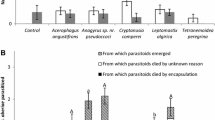Abstract
Anagyrus indicus Shafeeet al. was collected on the island of Guam and released in the Jordan River Valley of Jordan in order to regulateNipaecoccus viridis (Newstead) on citrus.A. indicus was originally released in February 1984 and became colonized by April of the same year. It also dispersed by natural means up to 61 km following the original release and colonized that same year on infestedZizyphus sp. By spring of 1985 it became the dominant parasitoid attackingN. viridis. Another parasitoid,Anagyrus kamali Moursi, was collected in Jordan in June of 1985 for the first time. This latter parasitoid apparently moved into the Jordan River Valley by means of natural dispersal from a neighboring country. Infestations ofN. viridis have been greatly reduced in areas whereA. indicus became established.
Résumé
Anagyrus indicus Shafeeet al. a été récolté à l'île de Guam et lâché dans la vallée du Jourdain en Jordanie afin de réduire les populations deNipaecoccus viridis (Newstead) sur citrus. A l'origineA. indicus fut lâché en février 1984 et s'implanta en avril de la même année. Il se dispersa aussi naturellement à plus de 61 kms du point de lâcher d'origine et s'établit la même année sur lesZizyphus infestés. Au printemps 1985, il devint le parasitoid dominant attaquantN. viridis. Un autre parasitoid,Anagyrus kamali Moursi, a été récolté en Jordanie en juin 1985 pour la 1re fois. Ce dernier parasitoïde arrivait apparemment d'une région voisine dans la vallée du Jourdain par les moyens naturels de dispersion. Les infestations dues àN. viridis ont été fortement réduites là oùA. indicus s'est établi.
Similar content being viewed by others
References
Anonymous.—1983. Distribution maps of insect pests.—Eastern Press, London, England. Map No. 446.
Abdul-Rasoul, M. S.—1970. Notes onNipaecoccus vastator (Maskell) (Coccidae). A serious pest of citrus trees and various plants.—Bull. Iraq. Nat. Hist. Mus., 4, 105–106.
Ali, S. M.—1961. A note onNipaecoccus vastator (Mask.) [Pseudococcidae: Hemiptera].—Ind. J. Entomol., 23, 304–405.
Ali, S. M.—1967. Description of a new and records of some known Coccids (Homoptera) from Bihar, India.—Oriental Insects, 1, 30–34.
Al-Rawy, M. A., Kaddou, I. K. &Al-Omar, M. A.—1977. The present status of the spherical mealybug,Nipaecoccus vastator (Mask.) [Homoptera: Pseudococcidae] in Iraq.—Bull. Biol. Res. Center, 8, 3–15.
Beardsley, Jr., W. J.—1969. The Anagyrina of the Hawaiian Islands [Hymenoptera: Encyrtidae] with descriptions of two new species.—Proc. Hawaiian Entomol. Soc., 20, 287–310.
Chacko, M. J. &Deepak Singh, M. B.—1980. A note on the natural control ofNipaecoccus viridis on coffeee in India.—J. Coffee Res., 10, 63–64.
Clausen, C. P.—1978. Introduced parasites and predators of arthropod pests and weeds: A World Review.—Agric. Handbook No. 480. USDA, ARS Wash. DC, pp. 545.
El-Haidari, H. S., Aziz, F. I. & Wahab, W. A.—1974. Activity of the predators and parasites of the mealybug,Nipaecoccus vastator (Maskell) in Iraq.—Yearbook of Pl. Prot. Res. Iraq., 40–46.
Kamal Bey, M.—1951. Biological control projects in Egypt, with a list of introduced parasites and predators.—Bull. Soc. Fouad. 1er Entomol., 35, 205–220.
Moursi, A. A.—1948a. Description of two new species ofAnagyrus [Hymenoptera: Encyrtidae].—Bull. Soc. Fouad. 1er Entomol., 32, 1–7.
Moursi, A. A.—1948b.Anagyrus kamali Moursi, a parasite of the hibiscus mealybug,Phenococcus hirsutus Green.—Bull. Soc. Fouad. 1er Entomol., 32, 9–16.
Moursi, A. A.—1948c.Anagyrus aegyptiacus Moursi, a parasite of the Lebbek mealybug,Pseudococcus filamentosus Ckll.—Bull. Soc. Fouad. 1er Entomol., 32, 17–32.
Moursi, A. A.—1948d.Leptomastix phenacocci Compere, a parasite of the Lebbek mealybug,Pseudococcus filamentosus Ckll.—Bull. Soc. Fouad. 1er Entomol., 32, 33–40.
Nechols, J. R. &Kikuchi, R. S.—1985. Host selection of the spherical mealybug [Homoptera: Pseudococcidae] byAnagyrus indicus [Hymenoptera: Encyrtidae] influence of host stage on parasitoid oviposition, development, sex ratio, and survival.—Environ. Entomol., 14, 32–37.
Nechols, J. R. &Seibert, T. F.—1985. Biological control of the spherical mealybug,Nipaecoccus vastator [Homoptera: Pseudococcidae]: assessment by ant exclusion.—Environ. Entomol., 14, 45–47.
Shalaby, F.—1961. A preliminary survey of the insect fauna of Saudi Arabia.—Soc. Entomol. d'Egypte Bull., 45, 211–216.
Willcocks, F. C.—1910. A mealybug injurious to the lebbek trees of Cairo.—Bull. Entomol. Res. London, 1, 121–137.
Williams, D. J.—1985. Australian mealybugs.—Br. Mus. of Nat. Hist., London, England pp. 431.
Zi-Qing, W.—1982 Economic insect fauna of China.Homoptera: Pseudococcidae—Fasc. 24.—Science Press, Beijing, China pp. 117.
Author information
Authors and Affiliations
Additional information
This paper reports the results of research only. Mention of a proprietary product does not constitute an endorsement for its use by USDA.
Rights and permissions
About this article
Cite this article
Meyerdirk, D.E., Khasimuddin, S. & Bashir, M. Importation, colonization and establishment ofAnagyrus indicus [Hym.: Encyrtidae] onNipaecoccus viridis [Hom.: Pseudococcidae] in Jordan. Entomophaga 33, 229–237 (1988). https://doi.org/10.1007/BF02372658
Received:
Accepted:
Issue Date:
DOI: https://doi.org/10.1007/BF02372658




